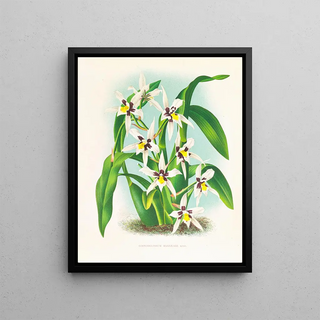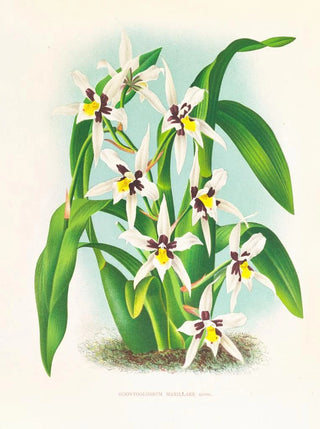Art print | Odontoglossum maxillare - Jean Jules Linden


View from behind

Frame (optional)
In the fascinating world of floral art, "Odontoglossum maxillare - Jean Jules Linden" emerges as an iconic piece, capturing the very essence of natural beauty. Jean Jules Linden, a 19th-century Belgian botanist and painter, masterfully combined his love for flora with undeniable artistic talent. This artwork, depicting a majestic orchid, does not merely reproduce reality; it elevates it. Immersed in this piece, the viewer is transported to a lush garden, where each petal seems to vibrate under the light. The meticulous representation of the plant reflects thorough observation and rare aesthetic sensitivity.
Style and uniqueness of the work
The piece stands out for its delicate color palette, oscillating between soft hues and striking contrasts. Shades of green, yellow, and violet intertwine harmoniously, creating a lively tableau that captures the eye and awakens the senses. The precision of details, from the veins of the leaves to the textures of the flowers, reveals exceptional craftsmanship. Linden does not merely depict a simple orchid; he brings to life a floral composition that breathes elegance and sophistication. Every element is carefully arranged, demonstrating technical mastery that transcends mere realism. This unique style, blending botany and art, makes this work a true ode to nature, where each glance reveals new subtleties.
The artist and his influence
Jean Jules Linden, born in 1817 and deceased in 1868, left his mark on his era through his passion for exotic plants and his desire to immortalize them through art. Raised in an environment where nature was celebrated, he developed a fascination for orchids, which he explored during his travels in South America. His work not only contributed to documenting these rare species but also influenced many contemporary artists and botanists. Linden successfully bridged science and art, proving that natural beauty can be an inexhaustible source of inspiration. His legacy endures today, inspiring generations of artists to explore the relationship between man and nature.

Matte finish

View from behind

Frame (optional)
In the fascinating world of floral art, "Odontoglossum maxillare - Jean Jules Linden" emerges as an iconic piece, capturing the very essence of natural beauty. Jean Jules Linden, a 19th-century Belgian botanist and painter, masterfully combined his love for flora with undeniable artistic talent. This artwork, depicting a majestic orchid, does not merely reproduce reality; it elevates it. Immersed in this piece, the viewer is transported to a lush garden, where each petal seems to vibrate under the light. The meticulous representation of the plant reflects thorough observation and rare aesthetic sensitivity.
Style and uniqueness of the work
The piece stands out for its delicate color palette, oscillating between soft hues and striking contrasts. Shades of green, yellow, and violet intertwine harmoniously, creating a lively tableau that captures the eye and awakens the senses. The precision of details, from the veins of the leaves to the textures of the flowers, reveals exceptional craftsmanship. Linden does not merely depict a simple orchid; he brings to life a floral composition that breathes elegance and sophistication. Every element is carefully arranged, demonstrating technical mastery that transcends mere realism. This unique style, blending botany and art, makes this work a true ode to nature, where each glance reveals new subtleties.
The artist and his influence
Jean Jules Linden, born in 1817 and deceased in 1868, left his mark on his era through his passion for exotic plants and his desire to immortalize them through art. Raised in an environment where nature was celebrated, he developed a fascination for orchids, which he explored during his travels in South America. His work not only contributed to documenting these rare species but also influenced many contemporary artists and botanists. Linden successfully bridged science and art, proving that natural beauty can be an inexhaustible source of inspiration. His legacy endures today, inspiring generations of artists to explore the relationship between man and nature.






